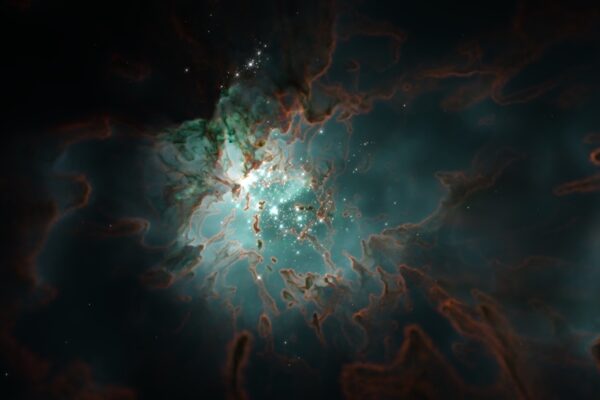2022-08-08 テキサス大学オースチン校(UT Austin)

Mock narrowband observation of a simulated star-forming region where massive stars destroy their parent cloud. Credit: STARFORGE
「原始星」の周囲には、ガスとダストの円盤が回転している。太陽系にあるすべての惑星は、かつて生まれたばかりの太陽の周りにあるこのような円盤の中の一点だったのです。恒星の周りを回る惑星が生命を宿すかどうかは、恒星の質量とその形成過程によって決まります。したがって、宇宙で生命が誕生する場所を決めるには、星の形成を理解することが非常に重要なのです。
太陽よりはるかに大きな星はまれで、生まれたばかりの星のわずか1%しか存在しません。また、生まれたばかりの星1つに対して、太陽のような星が10個、矮星(わいせい)が30個も存在します。この比率(星の初期質量関数IMF)は、天の川のどこを見ても、生まれたばかりの星団も、何十億年も前の星団も同じであることが、観測からわかりました。
私たちの銀河系や、私たちを取り囲む矮小銀河のどの星の集団も、何十億年もかけて全く異なる条件で生まれたにもかかわらず、このように同じバランスを持っているのです。理論的には、IMFは劇的に変化するはずなのですが、事実上普遍的であるため、天文学者は何十年にもわたって困惑してきました。
この研究は、世界で最も強力な2台のスーパーコンピュータを用いて行われた。UT AustinのTexas Advanced Computing CenterのFronteraとStampede2です。これらのシミュレーションは、崩壊しつつある巨大雲中の個々の星の形成を追跡すると同時に、形成されたばかりの星が光を放ったり、ジェットや風によって質量を放出するなど、周囲とどのように相互作用するかを捉えた初めてのものです。”星のフィードバック “と呼ばれる現象が見られます。
<関連情報>
- https://news.utexas.edu/2022/08/08/stars-shed-light-on-why-stellar-populations-are-so-similar-in-milky-way/
- https://academic.oup.com/mnras/advance-article-abstract/doi/10.1093/mnras/stac2060/6650369
STARFORGEシミュレーションにおける星の初期質量関数への環境とフィードバック物理の影響 Effects of the environment and feedback physics on the initial mass function of stars in the STARFORGE simulations
Dávid Guszejnov, Michael Y Grudić, Stella S R Offner, Claude-André Faucher-Giguère, Philip F Hopkins, Anna L Rosen
Monthly Notices of the Royal Astronomical Society Published::26 July 2022
DOI:https://doi.org/10.1093/mnras/stac2060
Abstract
One of the key mysteries of star formation is the origin of the stellar initial mass function (IMF). The IMF is observed to be nearly universal in the Milky Way and its satellites, and significant variations are only inferred in extreme environments, such as the cores of massive elliptical galaxies and the Central Molecular Zone. In this work we present simulations from the STARFORGE project that are the first cloud-scale radiation-magnetohydrodynamic simulations that follow individual stars and include all relevant physical processes. The simulations include detailed gas thermodynamics, as well as stellar feedback in the form of protostellar jets, stellar radiation, winds and supernovae. In this work we focus on how stellar radiation, winds and supernovae impact star-forming clouds. Radiative feedback plays a major role in quenching star formation and disrupting the cloud, however the IMF peak is predominantly set by protostellar jet physics. We find the effect of stellar winds is minor, and supernovae ‘occur too late’ to affect the IMF or quench star formation. We also investigate the effects of initial conditions on the IMF. We find the IMF is insensitive to the initial turbulence, cloud mass and cloud surface density, even though these parameters significantly shape the star formation history of the cloud, including the final star formation efficiency. Meanwhile, the characteristic stellar mass depends weakly on metallicity and the interstellar radiation field, which essentially set the average gas temperature. Finally, while turbulent driving and the level of magnetization strongly influences the star formation history, they only influence the high-mass slope of the IMF.



